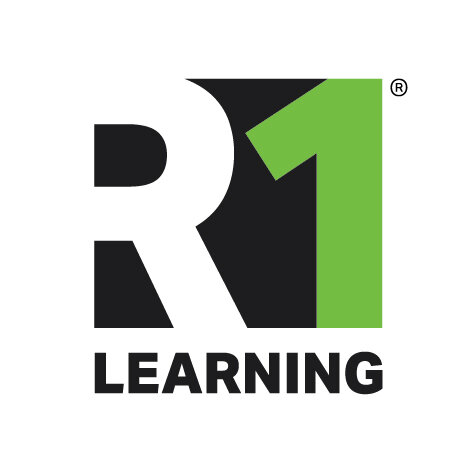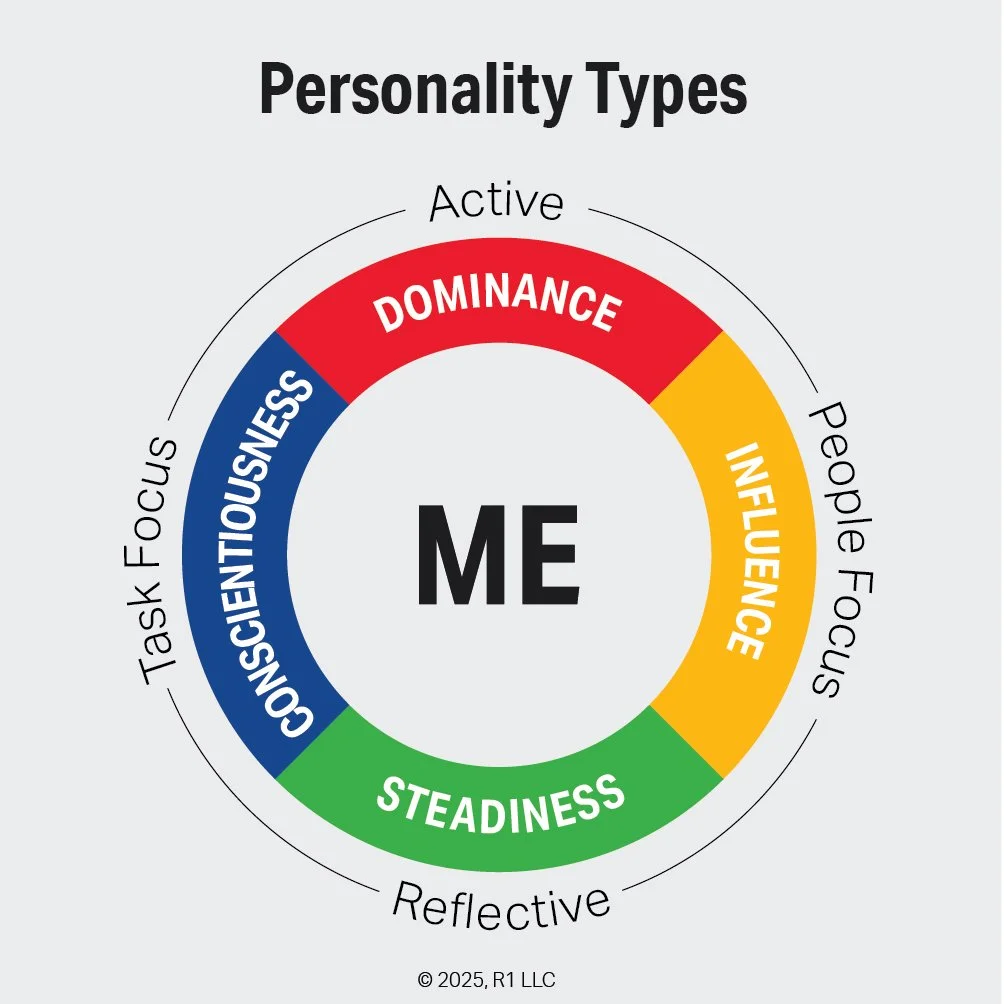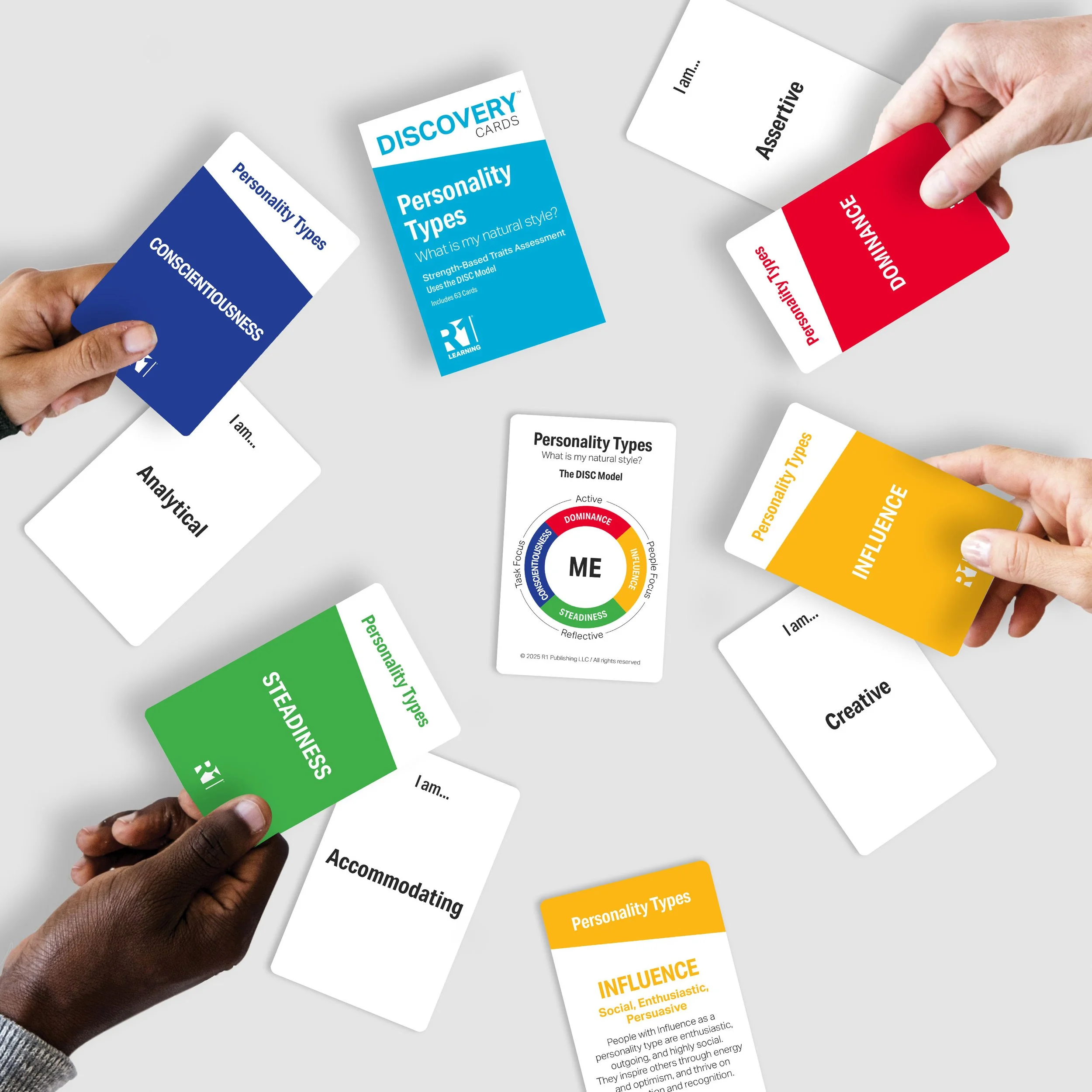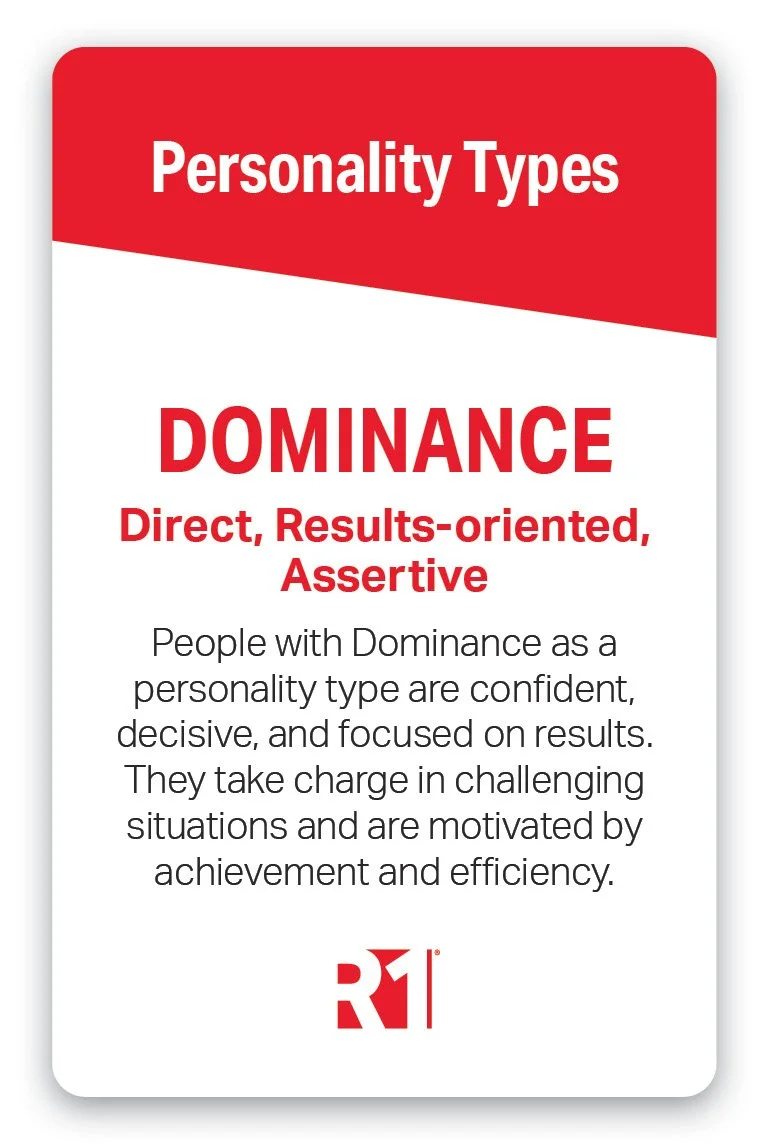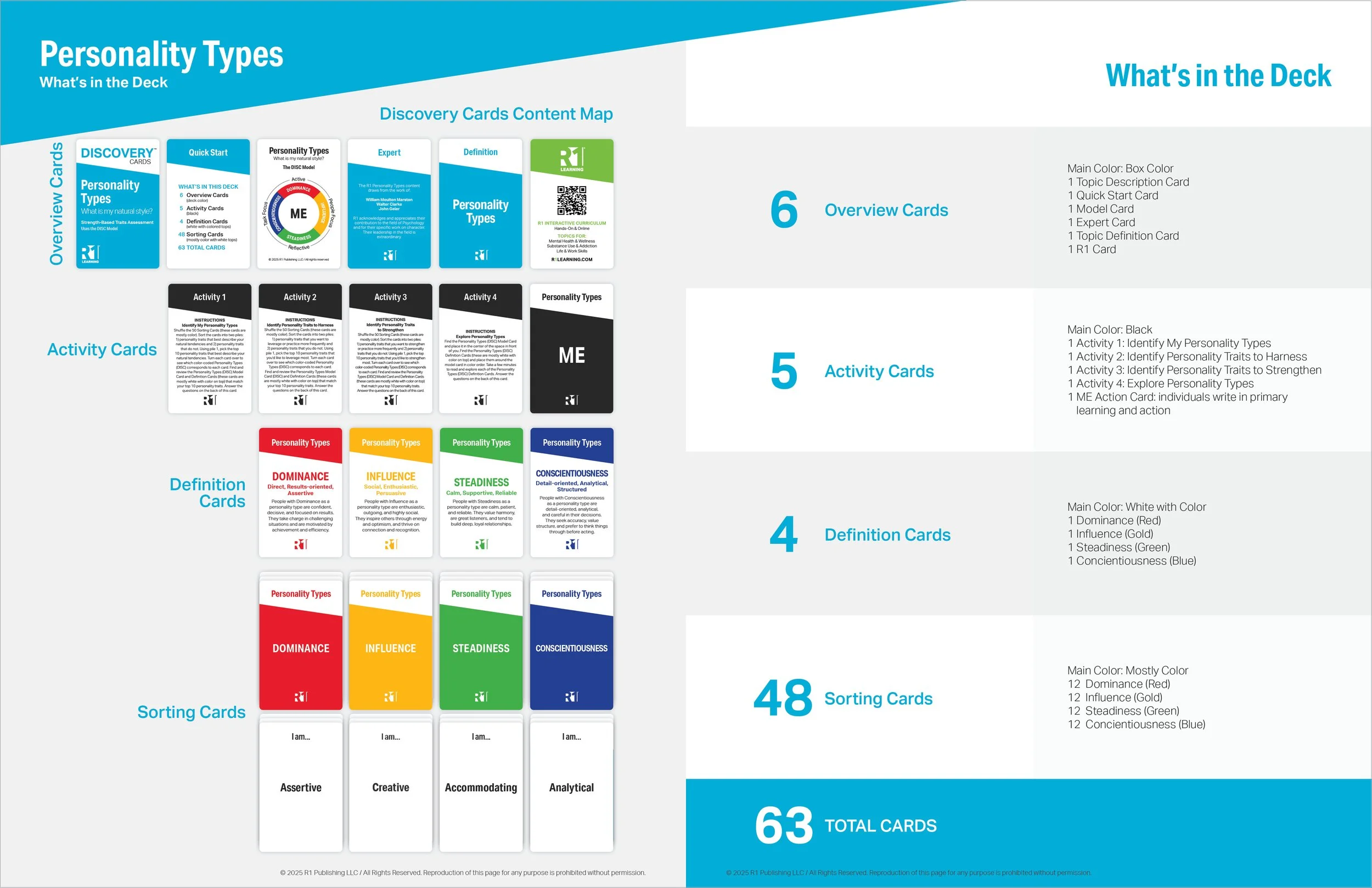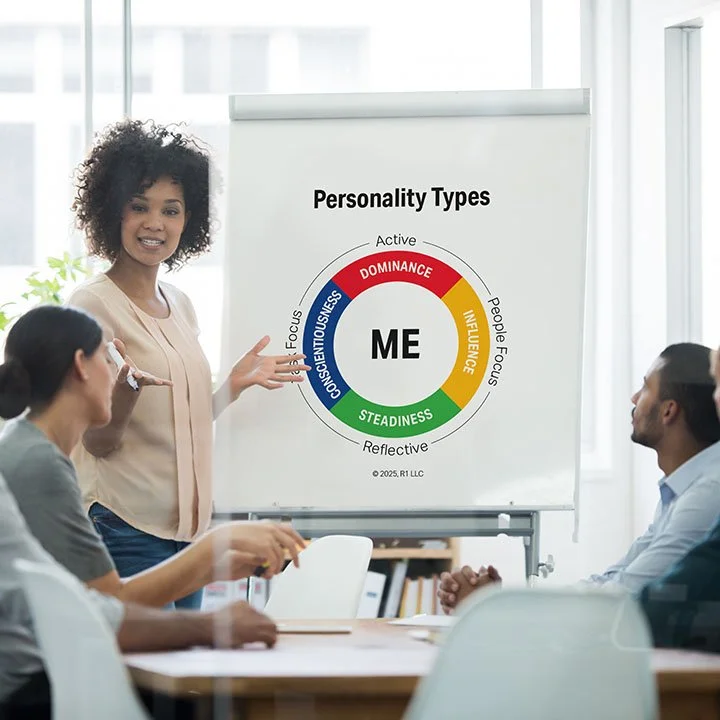4 Personality Types — What is my natural style? Uses the DISC Model
Exploring personality types is essential for understanding one’s natural tendencies and style and how to leverage one’s strengths on teams, in groups, and when interacting in social settings. Understanding personality types fosters empathy, improves communication, and builds stronger relationships both personally and professionally.
One of the most widely used personality types frameworks is the DISC model comprising the following four types: Dominance, Influence, Steadiness, Conscientiousness. The DISC model originated in 1928 when psychologist and author William Moulton Marston introduced a four-part theory of behavior in his book Emotions of Normal People. Marston proposed that people tend to respond to their environment based on how they perceive control and favorability, which he categorized into four types. While Marston did not create a formal assessment, his ideas laid the foundation for future tools that would measure and apply these personality styles.
Over the decades, Marston’s theory was developed into practical assessments that could be used in personal and professional settings. In the 1950s, Walter Clarke created the first DISC-based personality profile for workplace use, and in the 1970s, John Geier helped refine and popularize it with the Personal Profile System. Today, DISC assessments are widely used in business, education, coaching, and leadership development. They help individuals recognize their communication styles, improve teamwork, reduce conflict, and better understand how their behaviors affect others. Rather than focusing on deep-seated personality traits, DISC emphasizes observable behavior—making it especially useful for improving real-world interaction and collaboration.
Within each of these four types reside the different, more specific traits that are associated with the personality type. For example, within the broader category of Steadiness you can find traits such as collaboration, humility, and patience. Looking closely at the traits that shape personality can help individuals gain insight into their strengths, areas for growth, and natural styles of communication and collaboration. It may also help an individual recognize personality types and traits in others, and in doing so, help improve their interactions and relationships.
The purpose of today’s post is to share the basics of our new Personality Types topic so you can explore how best to use it with individuals in your setting. Take a moment to review the definitions and examples for each of the 4 Personality Types below. Then read through the Questions to Explore for yourself or with others in your organization. The R1 Personality Types Group Kits and R1 Discover App provide tools for engagement, education, and empowerment for individuals you work with or support. Implementing these tools often through practice is one of the best ways to learn. It’s all about practice… practice, practice, practice.
Personality Types Defined
What is personality? Personality is composed of a set of qualities and attributes that describe the consistent patterns in how individuals tend to think, feel, and behave. These patterns of traits shape how individuals respond to challenges, interact with others, and approach tasks. Personality types help explain differences in communication, decision-making, and emotional responses. Identifying one's personality type can help an individual better understand their natural tendencies, communication style, and decision-making patterns—insight that can lead to stronger relationships, improved self-awareness, and more effective collaboration with others.
Personality Types — Uses the DISC Model
The 4 Personality Types are listed below. For each, you will find a brief definition, examples of the Discovery Card’s behavioral statements, and Questions to Explore. Please note that all of this information, and more, is listed in the Personality Types Topic Kit (which includes 1 Discovery Cards deck and 1 Facilitator Guide) located on the R1 Store.
Dominance — Direct, Results-oriented, Assertive: People with Dominance as a personality type are confident, decisive, and focused on results. They take charge in challenging situations and are motivated by achievement and efficiency.
5 of 10 Discovery Cards Examples:
Assertive
Confident
Decisive
Purposeful
Results-oriented
Influence — Social, Enthusiastic, Persuasive: People with Influence as a personality type are enthusiastic, outgoing, and highly social. They inspire others through energy and optimism, and thrive on connection and recognition.
5 of 10 Discovery Cards Examples:
Creative
Inspiring
Optimistic
Persuasive
Positive
Steadiness — Calm, Supportive, Reliable: People with Steadiness as a personality type are calm, patient, and reliable. They value harmony, are great listeners, and tend to build deep, loyal relationships.
5 of 10 Discovery Cards Examples:
Cooperative
Dependable
Humble
Patient
Persistent
Conscientiousness — Detail-oriented, Analytical, Structured: People with Conscientiousness as a personality type are detail-oriented, analytical, and careful in their decisions. They seek accuracy, value structure, and prefer to think things through before acting.
5 of 10 Discovery Cards Examples:
Analytical
Careful
Conscientious
Logical
Organized
A Toolkit For Engagement — What’s In the Deck
Questions to Explore
Answer the following questions for yourself or with your team:
What do you find helpful about the Personality Types Model?
How will the Personality Types Model be most useful for you and your team? Explain.
How does your knowledge of the 4 Personality Types help you to better understand the strengths and needs of the individuals you serve?
How can you and your team use this information to engage and support individuals in your program?
What are some areas in your program where you can incorporate Personality Types activities?
What will be the benefit for you and others as you use this tool?
What is your major learning or takeaway from this post? Explain.
R1 DISC Tool Disclaimer: The R1 Personality Types Discovery Cards deck, based on the DISC model, is a non-validated, non-psychometric instrument, that helps individuals explore and strengthen personality traits. Although other DISC instruments focus on leveraging one’s identified Personality Type, R1’s additional focus is to help individuals learn more about themselves, identify strengths, and see benefits for strengthening any trait. Being more assertive or decisive (D); pushing oneself to be more positive or optimistic (I); being more cooperative or dependable (S); or being more organized or detailed (C); can all be helpful traits for personal development and growth even if these traits are not associated with one's natural DISC personality types.
Thank you for reading this post and participating in this activity. Contact us if you would like to learn more about our Personality Types solutions and the R1 Learning System. We look forward to hearing from you.
References
Marston, W. M. (1928). Emotions of Normal People. Kegan Paul, Trench, Trübner & Co.
Merenda, P. F., & Clarke, W. V. (1965). Self-description and personality measurement. Journal of Clinical Psychology, 21(1), 52-56.
Geier, J. G. (1974). The Personal Profile System: Theory, measurement, and application (Unpublished manuscript / technical report).
Inscape Publishing / Wiley. (n.d.). The Personal Profile System and Models of Personality (research report). In PPSMOPO series.
Gianakos, D. (2023). Building emotional intelligence through the DiSC assessment. Physician Leadership Journal, 10(4), 52-54. https://doi.org/10.55834/plj.6311340293
Copyright 2025 R1 Publishing LLC / All Rights Reserved. Use of this article for any purpose is prohibited without permission.
Engagement Tools
Integrating Discovery Card activities into your groups and one-on-ones will allow individuals to think concretely, increase self-awareness, build vocabulary, express themselves more effectively, and put insights into action. Visit the R1 Store to learn more about these evidence-based topics and models.
Here are a few ideas to help you learn more about R1 and engage others on this topic:
Share this blog post with others. (Thank you!)
Start a conversation with your team. Bring this information to your next team meeting or share it with your supervisor. Change starts in conversations. Good luck! Let us know how it goes.
Visit www.R1LEARNING.com to learn more about R1, the Discovery Cards, and how we’re creating engaging learning experiences through self-discovery.
